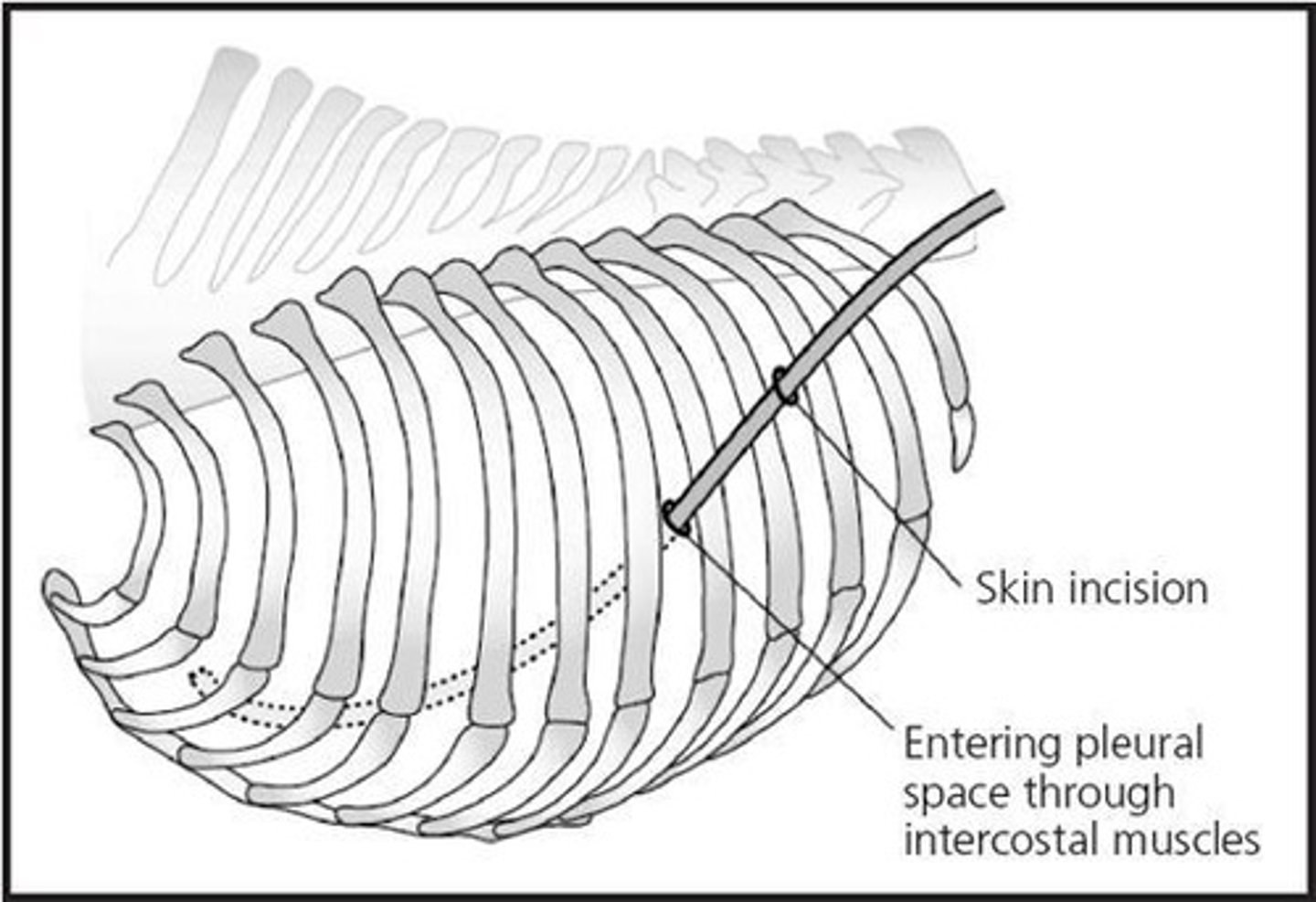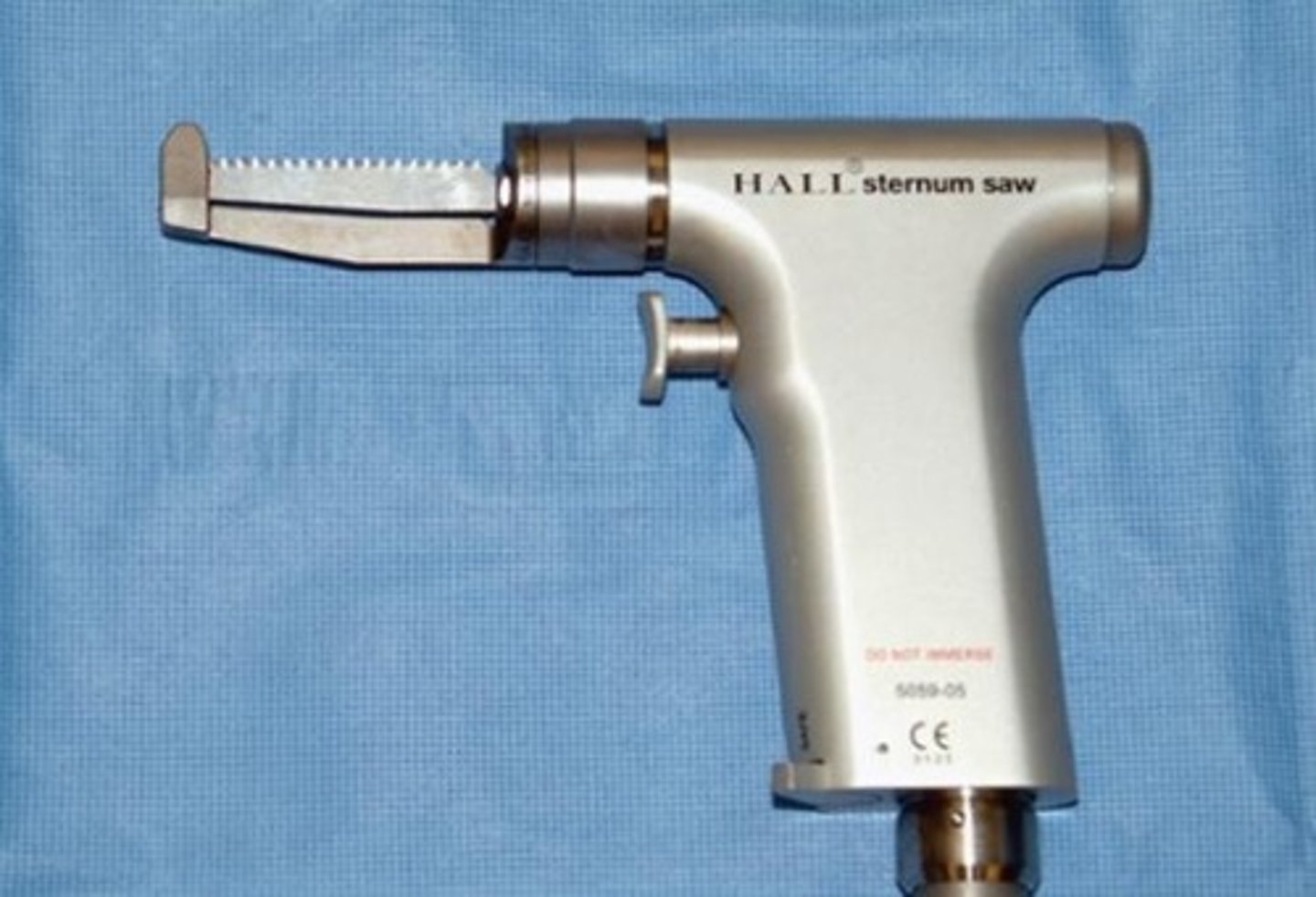Principles of Thoracic Surgery in Veterinary Medicine
1/89
There's no tags or description
Looks like no tags are added yet.
Name | Mastery | Learn | Test | Matching | Spaced |
|---|
No study sessions yet.
90 Terms
Thoracotomy
surgical incision of the chest wall.
Intercostal / Lateral Thoracotomy
performed by incising between ribs.
Median Sternotomy
performed by splitting the sternum.
Pulmonary Lobectomy
removal of a lung lobe or a portion of a lung lobe.
Complete Lobectomy
removal of a lung lobe.
Partial Lobectomy
removal of a portion of a lung lobe.
Pneumonectomy
removal of all lung tissue on one side of the thoracic cavity.
Diagnostic biopsy
a procedure to obtain tissue samples for diagnosis.
Cardiovascular Surgery
surgery related to the heart and blood vessels.
Patent Ductus Arteriosus
a heart defect that affects blood flow.
Vascular Ring Anomalies
abnormalities in the blood vessels that can compress the esophagus or trachea.
Open Heart Procedures
surgical operations performed on the heart.
Neoplasia
the presence of a tumor or abnormal growth of tissue.
Pericardiectomy
surgical removal of the pericardium.
Emergency Stabilization
initial treatment to stabilize a patient in critical condition.
Flail Chest
a condition where multiple ribs are broken, causing respiratory impairment.
Acute Respiratory Impairment
sudden decrease in the ability to breathe effectively.
Thoracentesis
a procedure to remove fluid from the pleural space.
Oxygen Therapy
the administration of oxygen to improve oxygenation.
Blood gas analysis
a test that measures the levels of oxygen and carbon dioxide in the blood.
Pre-emptive Analgesia
administration of pain relief before a surgical procedure.
Intermittent Positive Pressure Ventilation (IPPV)
a method of mechanical ventilation that delivers breaths to a patient.
Premedication
medications given before anesthesia to prepare the patient.
Auscultation
Both sides of the chest cavity should be auscultated.
Endotracheal tube placement
Endotracheal tube palpated in the thoracic inlet to ensure proper placement.
End-tidal CO2 (EtCO2)
Confirmation should be made with the presence of end-tidal CO2 (EtCO2).
Intermittent positive pressure ventilation
Animals with open chest cavities (including those with diaphragmatic hernias) require intermittent positive pressure ventilation.
Arterial blood gas
Arterial blood gas is the gold standard for evaluation of ventilation and oxygenation.
Capnometry
Noninvasive technique for ventilation.
Pulse oximetry
Noninvasive technique for oxygenation.
Hypoventilation
EtCO2 - helpful in identifying potentially life-threatening situations such as hypoventilation.
Airway obstruction
EtCO2 - helpful in identifying potentially life-threatening situations such as airway obstruction.
Hypotension
EtCO2 - helpful in identifying potentially life-threatening situations such as hypotension.
Ventilator malfunctions
EtCO2 - helpful in identifying potentially life-threatening situations such as ventilator malfunctions.
Esophageal intubation
EtCO2 - helpful in identifying potentially life-threatening situations such as esophageal intubation.
Normal PaCO2
Normal PaCO2 = 35 to 45 mmHg.
Respiratory acidosis
PaCO2 >60 mm Hg indicates respiratory acidosis due to hypoventilation and would be an indication for IPPV.
Extubation
Extubation should not be rushed; patient should be awake and not overly sedated, respirations are adequate, and patient is comfortable prior to extubation.
Prophylactic antibiotics
Prophylactic antibiotics given at induction include Cefazolin 22 mg/kg IV.
Amoxicillin/sulbactam (Unasyn)
Amoxicillin/sulbactam (Unasyn) 30 mg/kg IV at induction; repeat once or twice at 90-minute to 2-hour intervals.
Therapeutic antibiotics
Therapeutic antibiotics should be initiated at the earliest sign of infection.
Leukocytosis
Leukocytosis is a sign for initiating therapeutic antibiotics.
Fever
Fever is a sign for initiating therapeutic antibiotics.
Ampicillin
Ampicillin is used until culture and sensitivity results are available.
Clindamycin
Clindamycin is used until culture and sensitivity results are available.
Enrofloxacin
Enrofloxacin is used until culture and sensitivity results are available.
Prophylactic antibiotic considerations
Appropriate use of prophylactic antibiotics depends on length of surgery, type of surgery, immune status, and underlying disease process.
Debilitated animals
Debilitated animals undergoing thoracotomy for removal of large neoplastic lesions are likely to benefit from prophylactic antibiotic therapy.
Thoracostomy tube
Place a thoracostomy tube through an intercostal space one to two spaces caudal to the incision prior to closing the thorax.

Rib approximator
Use a rib approximator or have an assistant cross two sutures to appose the ribs.
Median Sternotomy
A surgical procedure that provides exposure to both sides of the thoracic cavity.
Bilateral partial lobectomy
A surgical procedure that can be easily performed through median sternotomy, while complete lobectomy may be challenging.
Structures isolated in median sternotomy
Includes the Caudal Vena Cava, Main Pulmonary Artery, and both sides of the Pericardial Sac.
Indications for a Median Sternotomy
Conditions such as Mediastinal Tumors, Pericardiectomy, Spontaneous Pneumothorax, Trauma, and Exploratory Thoracotomy.
Postoperative considerations
Two or three sternebrae should be left intact cranially or caudally to reduce postoperative pain and prevent delayed healing.
Sternotomy extension for lung or heart exposure
Should extend from the xiphoid cartilage cranially to the second or third sternebra.
Sternotomy extension for cranial mediastinum exposure
Should extend from the manubrium caudally to the sixth or seventh sternebra.
Sternal Saw
Special equipment used for performing median sternotomy.

Oscillating Orthopedic Saw
Another special equipment used for median sternotomy.
Median Sternotomy Procedure
Involves incising the skin on the midline over the sternum and exposing the sternum through sharp incision and blunt dissection.
Sternal saw guide
A feature that sits under the sternum to facilitate cutting without damaging the heart or lungs.
Closure of sternotomy in dogs over 15 kg
Should be done with wires.
Closure of sternotomy in cats and small dogs
Should be done with heavy suture.
Figure-eight pattern closure
Wire or suture is placed around the sternebrae in a figure-eight pattern for closure.
Stability of wire closures
In large dogs, sternotomies closed with wire may be more stable due to healing associated with chondral or osteochondral bridging.
Suture closure comparison
Recent studies indicate that suture closures (polydioxanone or nylon) are mechanically comparable to wire.
Biomechanical loading in closure
Single or double-twist figure-eight patterns centered between two sternebrae are associated with least displacement during loading.
Double-loop cerclage wiring
Should be avoided due to a high failure rate under load.
Median Sternotomy Closure
Suture the subcutaneous tissue in a simple continuous pattern with absorbable suture. Remove residual air from the thoracic cavity and close the skin routinely.
Partial Pulmonary Lobectomy
Performed via Intercostal Thoracotomy or a Median Sternotomy. Identify lung tissue to be removed and place crushing forceps proximal to the lesion.
Continuous Overlapping Suture Pattern
Place a continuous, overlapping suture pattern proximal to the forceps during a Partial Pulmonary Lobectomy.
Lung Excise Procedure
Excise the lung between the suture lines and clamps, then oversew the lung in a simple continuous pattern with absorbable suture.
Thoracoabdominal (TA) Stapler
Used in Partial Pulmonary Lobectomy.
Complete Pulmonary Lobectomy
Ligate and transect the vasculature to the affected lobe.
Satinsky Clamp
Used to double clamp the main bronchus during a Complete Pulmonary Lobectomy.
Bronchus Suture Pattern
Suture the bronchus in a continuous horizontal mattress pattern.
Postoperative Care and Assessment
Monitor respiration closely once the animal begins ventilating on its own.
Thoracic Radiographs
Should be examined for evidence of pneumothorax if there is any doubt about residual air after thoracic closure.
Blood Gas Analysis
Helps evaluate adequacy of ventilation in postoperative care.
Hypoxic Animals Treatment
Should receive oxygen by nasal insufflation or oxygen cage.
Multimodal Analgesia
Needed in all patients undergoing thoracotomy procedures.
Post-op Hypoventilation
Thoracic radiographs indicated to rule out pneumothorax, hemothorax, or pulmonary edema.
Hypothermia After Surgery
Common after thoracic surgery; patients should be rewarmed with warm water bottles, circulating warm water blankets, or warm air blankets.
Postoperative Complications
Reported in 39% of thoracic surgery cases, most consist of wound complications and problems with thoracic drain.
Incidence of Pyothorax
Found to be 6.5% in a study of 232 dogs with a mortality rate of 67%.
Subcutaneous Fluid Accumulation
Can occur at the ventral aspect of the thoracotomy incision; avoided by carefully closing the distal musculature.
Air Leakage or Hemorrhage
Major complication of partial or complete lobectomy; minor air leaks usually seal, but massive air leaks or severe hemorrhage require reoperation.
Median Sternotomy Complications
Adequate closure and leaving several sternebrae intact prevents delayed healing or nonunion of the sternebrae.
Postop Lameness
Associated with pain and severing of the latissimus dorsi muscle; usually resolves within 1 to 2 days.
Monitoring Postoperative Animals
Closely monitor for pneumothorax, hemothorax, or both in the early postoperative period.